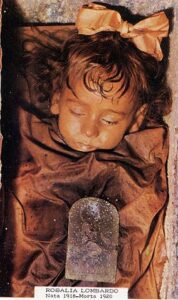Capuchin Catacombs Of Palermo: A Well Preserved Horror
We spent our honeymoon in Sicily: a wonderful Italian island with a lot of history, spectacular views, and excellent food. As with any trip, I researched the destination and its attractions in the weeks before to build a schedule. And then I saw it: the Capuchin catacombs of Palermo, which mainly contain well-embalmed mummies. “Umm, Honey? What do you think about this attraction?” I asked, proudly displaying a picture of a mum 5cmy monk I found on Google. “Do you think that on my honeymoon I will go to see mummies? Are there any romantic places in Sicily?”, answered my intended wife, leaving me speechless. “Um, it could be romantic. Oh – to symbolize the fact that our love will be eternal. You know, like the mummies,” I said apprehensively. As expected, it didn’t help. I had to give up visiting this mysterious place for now.
The Capuchin Monastery in Palermo, Sicily, is one of the strangest, scariest, and most disturbing places you can find in Italy, especially with the name of the catacombs below it. It may not be the ideal option for those organizing a honeymoon in Sicily. Visiting it will likely leave you with an open mouth, an upturned stomach, and discomfort. Here’s everything you need to know about this mysterious Capuchin Catacombs Of Palermo.
What Can You Find In the Capuchin Catacombs Of Palermo?
The story of the Capuchin monastery in Palermo, at least in the context of the catacombs and mummified bodies, begins in the 16th century. As has happened several times throughout history – for example, the famous catacombs of Paris or the Jewish cemetery of Prague – at some point, the monastery that operated there ran out of standard burial places. The monks decided there was no escape but to dig burial tunnels under the church. The first resident there was a monk named Silvestro of Gubbio, who died in 1599. After the monks embalmed him, they transferred him to eternal rest at the burial site.
In the years since then, the catacombs of the Capuchins were mainly used for monks’ burials. But the rumor about the unique preservation and embalming process here gained wings. Dignitaries came from all over Sicily, asking that they or their loved ones be buried underground, sometimes thinking it was a status symbol. The strict among them even specified precisely how they wanted to be dressed and in what position their specialist would be.
The population of mummies underground has grown significantly, mainly thanks to donations made by the families of the deceased and other sources. The bodies had a temporary burial place. Upon receipt of payment, they moved it to the permanent residence until the family stopped paying, making it possible to free up an exclusive burial place for new bodies.

Bodies continued to be buried and mummies embalmed in the catacombs for decades until their official closure in 1880. In practice, however, it is said that the burial here continued until at least the 20s of the last century. In total, you will find in the Capuchin catacombs in Palermo about 8,000 bodies and about 2,000 mummies scattered throughout the entire complex and primarily close to the walls.
Rather gruesomely, they are divided into different groups, including men, women, children, monks, priests, professionals, and even virgins, so that you can see this place as a creepy museum of the dead. The cynics will say that this division proves that even in death, there can be class differences, and there is an influence on a specific person’s social affiliation.

The bodies and mummies in the Capuchin Catacombs Of Palermoare are preserved in relatively impressive condition, thanks to themeticulous embalming process or the conditions prevailing in the catacombs. But, unsurprisingly, there is no uniformity in the shape of the bodies: some of them are already decomposing, while others retain a “younger” appearance. It depends on the money paid or the identity of the buried person. Or that sometimes nature has its laws, both in life and in death.
The Art Of The Dead
The Capuchins did not invent embalming; even in ancient times, they used to embalm the dead, using different techniques that also partly changed over time. We learned on the site about other methods for preserving the deceased, such as the plasticization developed by Dr. Gunther von Hagens in the 1970s. In the case of the Capuchin Catacombs Of Palermo, the lengthy process began with the drying of the bodies of the buried, which was done along the ceramic tubes for about eight months. In some cases, the corpses were washed with vinegar, and in others – especially during epidemics when there was a fear that the dead would transmit the disease to others – they used a potent poison.
The arsenal of those buried in Capuchin Catacombs Palermo includes community leaders, politicians, artists (including painters and sculptors), respected professionals (such as lawyers and doctors), monks, priests, and more. Today, as the site’s official slogan states, it is a place where the living meet the dead. The mummified bodies were placed in utterly hermetic glass cabinets, usually fully clothed. As mentioned, each mummy had her requirements or those of the family members, and many preferred to be embalmed while standing and not lying down, as is done in tombs. Others, however, are buried in transparent coffins.

Rosalia Lombardo: The Most Beautiful Mummy In The World
It is impossible to remain indifferent to seeing a child’s corpse, and there is no doubt in this context that some of the child mummies in the Capuchin Catacombs Of Palermo cause the most significant discomfort. According to many, the body most associated with the place is that of Rosalia Lombardo. We don’t really know who was Rosalia Lombardo, rather that she was born in Palmero in 1918 but died a few days before her second birthday: possibly due to the terrible Spanish flu, or maybe due to pneumonia.

In his sorrow, her father turned to a well-known embalmer named Alfredo Salafia and asked him to preserve the body. His written memories, discovered over the years, showed exactly how he did it. He replaced Rosalia’s blood with formalin liquid to eliminate the bacteria. He used alcohol to cause the body to dry out and glycerin to prevent the body from being over-dried. He also used acid to get the hard and preserved look for a long time.
It is difficult to remain indifferent or dry-eyed when envisioning the chilling result of Rosalia Lombardo mummy, displayed inside a closed box alongside two other babies. Rosalia’s body was preserved in an impressive condition: for example, X-rays taken at one point showed that Salafia managed to protect her internal organs without any damage. However, over the years, they did notice specific changes and the beginning of Rosalia Lombardo decomposing, so they decided over time to change the burial’s location and the coffin’s characteristics.
It worked, and today little Rosalia’s body is preserved well in the Capuchin Catacombs Of Palermo. While some of the other mummies are in a state of decay or even look like a skeleton wearing clothes, as of recent years, Roelzia’s beauty still shines, with her fair hair and well-preserved waxy skin. She was nicknamed “Sleeping Beauty of the Capuchin Catacombs,” “Sleeping Beauty of Palermo,” or “The most beautiful mummy in the world.” A large part of the visitors to the Capuchin Catacombs Of Palermo Italy come mainly to see her, and over the years, stories have also surfaced about Rosalia Lombardo Eyes blinking. As the curator of the catacombs explains, it is simply an optical illusion caused by the changing light entering the catacombs’ windows.
Take a loot on this Rosalia Lombardo Blinking Video:
Next to Rosalia, you can see in the Capuchin Catacombs Of Palermo Children of all ages. These sad images can fit perfectly into a horror film: For example, two children embalmed in a sitting position on a rocking chair, one of the basic actions associated with the innocence and joy of life of the children, which at one point turned into deathly silence.
How Do You Visit The Capuchin Catacombs Of Palermo?
Today, the Capuchin catacombs in Palermo are open to the public. Please note that the visit is mainly based on impressions of the bodies when there is little information about them. In some cases, you won’t even be able to tell who precisely that mummy is or what the circumstances of her death are, which is entirely reasonable considering the number of burials or the events of their embalming.
Catacombs Palermo Opening Hours
The Capuchin Catacombs are open every day of the week, divided into two time intervals: in the morning between 9:00 and 12:30 (last admission at 12:15) and between 5:30 and 3:00 p.m. (last access at -17:15).
Catacombs Palermo Ticket Information
Starting in April 2023, the relatively modest price of the ticket will be 5 euros at the total cost and 3 euros at a discounted price. It seems you could only purchase tickets of this type at the box office.
Capuchin Catacombs In Palermo Tours
However, to understand precisely the story of the place, we recommend taking the Capuchin Catacombs Palermo tour. Choosing such a ticket with a guide, in English of course, which will provide you with the added value that is so important and will allow you to understand what you are seeing, what is the uniqueness of the place and other essential characteristics of Sicily and the fascinating history of the island. There are different types of tours, for example, a tour of several hours that departs from Palermo itself and includes other historical sites, a bicycle trip that combines a visit to the place, and more.
Here are some of the recommended tours on the spot, with the option of purchasing online and usually also a cancel option up to 24 hours before the date of the visit free of charge:
Order Different Tours on Viator
Order Private Tours on Get Your Guide
It is important to note that according to the official guidelines of Capuchin Palermo, you cannot photograph the bodies and mummies. Throughout the entire complex, there are countless signs indicating this. In practice, many do try to do it without noticing, and the cheeky ones even take a ridiculous selfie with a mummy.





